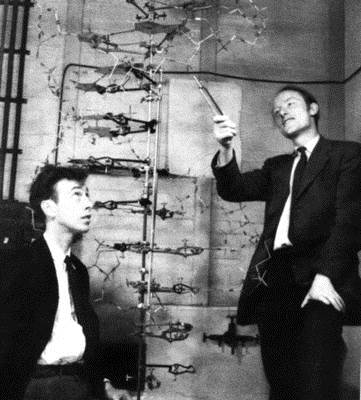DNA and Chromosome Structure
Sutton and Boveri proposed the chromosomal theory of heredity in 1902. However, because chromosomes (in bacteria and eukaryotes) contain proteins AND nucleic acid, there was still a significant question left: "Is the genetic material protein or nucleic acid?"
1) What experiment did Levene perform, what was his result, and what did he conclude about the structure of DNA? Given this, why did he hypothesize that proteins were the probable genetic material, not DNA?
2) Describe Griffith's experiment, explicitly describing why he believed that the heat-killed IIIs strain caused a HERITABLE CHANGE in the IIr strain. (Why is it not the case that the "transformation" could be explained as a consequence of the living IIr cells "colonizing" the polysaccharide capsules of the hk-IIIs, like a hermit crab in a snail shell?)
3) How does this bacterial transformation occur (think back to the last lecture)?
4) What are the contributions of Dawson and Galloway?
5) Describe the experiment by Avery, McCarty, and MacLeod, which proved that neither protein nor RNA was the transforming factor, but supported the conclusion that DNA was the transforming factor. So... see how useful our understanding of bacterial genetics has been? We actually determined that DNA is the heritable material by using bacteria, and their ability to absorb DNA from the environment.
6) Describe the Hershey-Chase experiment, explicitly describing the purpose of radioactively labeling P and S in differnt stocks, and following the radioactive fraction to see what viral molecules were absorbed by infected bacteria.
7) What are Chargaff's ratios, and what effect did they have on Levene's tetranucleotide hypothesis?
8) Draw a double-stranded DNA molecule with three base pairs. Be sure to highlight the complementary and anti-parallel properties of the molecule.
9) Explain how this structure accounts for Chargaff's rations, the conssitent width of the molecule over it's entire length, and the periodicities discovered by Astbury and Franklin.
10) What is a nucleosome? How can it influence the activity of a gene?11) Describe the higher levels of structure that occur in eukaryotic chromosomes during prophase condensation.
11) What is the "c-value paradox", and what is the solution? In other words, what are eukaryotes doing with all their extra DNA?
12) Why do viruses typically have small genomes? How does the exception (the mimiviruses like Pandoravirus) support this idea?
13) What evidence supports the "viruses-late" hypothesis and the "viruses early" hypothesis?
14) The majority of our DNA is "repetitive DNA" many of these sequences are transposons. What are transposons?
15) What is a retrotransposon? What is their relationship to retroviruses?
16) What are pseudogenes?
17) How can the proliferation of transposons and retrotransposons both TURN ON and TURN OFF genes?